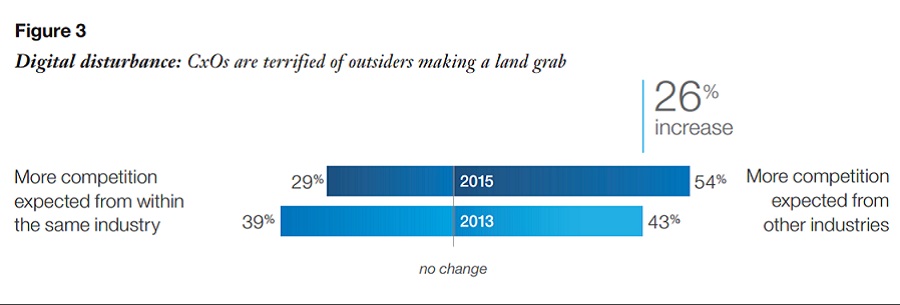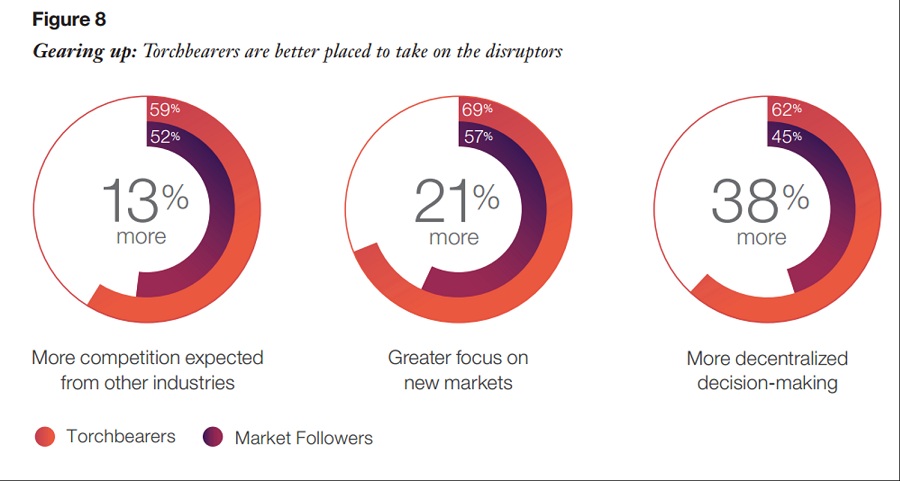The age of digital disruption is upon us, as the last decade alone has proven in terms of technology and disruption with the progression of organizations like Uber, Airbnb, and Netflix. We are also on the brink of new disruptions in industry, including banking or payments, insurance, healthcare, construction, packaging, and many more. These not only come from startups disrupting a sector, but companies being able to shift from their existing focus areas to build on new opportunities. They’re driven internally or by creating a new spinoff company into additional areas.
The CxO organization is becoming more concerned with outsiders entering into their markets. In the past, the cost of entry into a new market was significantly higher than it is today. Digital businesses and software-driven business models are changing the playing field, for new entrants to shift into new markets. The cost of experimentation continues to decrease, with lower cost computing models that allow for the rental of resources and software.
Open source plays a key role in both building new applications and creating community leverage; and senior executives are taking notice. IBM’s Global C-Suite Study is a great data set consisting of data collected between January and June 2015. They surveyed 5,247 business leaders from 21 industries in more than 70 countries. The sample comprises 818 CEOs, 643 CFOs, 601 CHROs, 1,805 CIOs, 723 CMOs, and 657 COOs :

Today’s native digital generations prefer to work on digital channels versus in-person channels. This ongoing trend has given rise to improvements in customer service, where interactions are delivered across multiple digital channels, ranging from social channels like Twitter and Facebook to text and voice communications. However, there is still more work to be done to unify these platforms more seamlessly. Technologies such as social, chat, and more recently, bots create the personal touch in a more scalable manner, reducing costs and increasing customer satisfaction. These trends will continually take hold, personalization and fast touch points are valued by today’s users who seemingly have less time than ever before.
The level of patience and complexity involved in making these channels seamless is an increasing challenge with today’s IT complexity. Your customers will not tolerate failure, and expect technology to just work. IBM’s survey data confirms this trend.

This accelerating trend is what will differentiate those businesses who learn to engage in new and differentiated ways across multiple channels. Companies which lead, versus those that follow have very different perspectives on what will likely transpire during a time of disruption.
In Figure 8 below, those indicated as torchbearers see companies who look for another market to expand into being able to enter these markets quickly as innovators in another segment or market. Similarly, these first-mover companies see the need to enter into new or adjacent markets. For this reason you see most companies creating labs or innovation centers. We increasingly see next generation visibility being required for these new and highly agile software systems. This demand is critical for survival, innovation, and growth.
These experiments can only be done promptly when the organization adopts smaller agile teams across the business and technology groups. Breaking up large, and likely slow moving monolithic organizations, software, and systems into smaller units which operate independently. The ability to experimentation and make decisions on their own.
The companies who lead tend to do this far more frequently than those who follow or are laggards. We see this regularly in our customer base, where a large degree of diversity exists in the autonomy within each team. The question remains as to how this will play out with economic changes or political change.

In summary, while this data and analysis confirm many trends, it shows clearly different and increasingly changed thinking as digital becomes the preferred channel for many businesses. The IBM data also informs that decentralized decision making and experimentation are clearly taking hold, but those who lead are in a different place than those who follow. It will be interesting to see how this progresses with IBMs new survey data.
The Latest
The use of hybrid multicloud models is forecasted to double over the next one to three years as IT decision makers are facing new pressures to modernize IT infrastructures because of drivers like AI, security, and sustainability, according to the Enterprise Cloud Index (ECI) report from Nutanix ...
Over the last 20 years Digital Employee Experience has become a necessity for companies committed to digital transformation and improving IT experiences. In fact, by 2025, more than 50% of IT organizations will use digital employee experience to prioritize and measure digital initiative success ...
While most companies are now deploying cloud-based technologies, the 2024 Secure Cloud Networking Field Report from Aviatrix found that there is a silent struggle to maximize value from those investments. Many of the challenges organizations have faced over the past several years have evolved, but continue today ...
In our latest research, Cisco's The App Attention Index 2023: Beware the Application Generation, 62% of consumers report their expectations for digital experiences are far higher than they were two years ago, and 64% state they are less forgiving of poor digital services than they were just 12 months ago ...
In MEAN TIME TO INSIGHT Episode 5, Shamus McGillicuddy, VP of Research, Network Infrastructure and Operations, at EMA discusses the network source of truth ...
A vast majority (89%) of organizations have rapidly expanded their technology in the past few years and three quarters (76%) say it's brought with it increased "chaos" that they have to manage, according to Situation Report 2024: Managing Technology Chaos from Software AG ...
In 2024 the number one challenge facing IT teams is a lack of skilled workers, and many are turning to automation as an answer, according to IT Trends: 2024 Industry Report ...
Organizations are continuing to embrace multicloud environments and cloud-native architectures to enable rapid transformation and deliver secure innovation. However, despite the speed, scale, and agility enabled by these modern cloud ecosystems, organizations are struggling to manage the explosion of data they create, according to The state of observability 2024: Overcoming complexity through AI-driven analytics and automation strategies, a report from Dynatrace ...
Organizations recognize the value of observability, but only 10% of them are actually practicing full observability of their applications and infrastructure. This is among the key findings from the recently completed Logz.io 2024 Observability Pulse Survey and Report ...
Businesses must adopt a comprehensive Internet Performance Monitoring (IPM) strategy, says Enterprise Management Associates (EMA), a leading IT analyst research firm. This strategy is crucial to bridge the significant observability gap within today's complex IT infrastructures. The recommendation is particularly timely, given that 99% of enterprises are expanding their use of the Internet as a primary connectivity conduit while facing challenges due to the inefficiency of multiple, disjointed monitoring tools, according to Modern Enterprises Must Boost Observability with Internet Performance Monitoring, a new report from EMA and Catchpoint ...






